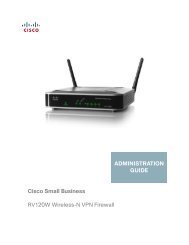Cisco WAP200 Wireless-G Access Point with PoE and ...
Cisco WAP200 Wireless-G Access Point with PoE and ...
Cisco WAP200 Wireless-G Access Point with PoE and ...
You also want an ePaper? Increase the reach of your titles
YUMPU automatically turns print PDFs into web optimized ePapers that Google loves.
<strong>Wireless</strong>-G <strong>Access</strong> <strong>Point</strong> <strong>with</strong> Power Over Ethernet <strong>and</strong> RangeboosterQoSThe following options are VLAN global settings for the <strong>Access</strong> <strong>Point</strong>.Default CoS (Priority). Select Enabled if you want to assign a default CoS value to each SSID. This option isautomatically enabled when the VLAN option is enabled. The default is Disabled.U-APSD (Unscheduled Automatic Power Save Delivery). This option is only available when WMM is enabledon any of the SSIDs. Select Enabled if you want client devices <strong>with</strong> U-APSD capability to take advantage of thepower save mode. The default is Disabled.SSID Name. Displays the SSIDs defined under the Basic <strong>Wireless</strong> Settings tab. If an SSID has been disabled, theoptions cannot be configured.VLAN ID. Select a number between 1 <strong>and</strong> 4094 to identify the VLAN. Multiple SSIDs can share the same VLANvalue.Priority. You can assign the default priority (802.1p COS bits) for packets coming in from each wireless networkby selecting a number from the drop-down menu. The higher the number, the higher the priority will be. Thedefault is 0.Tx Rate Limiting. You can limit the maximum data rate used in your network to save b<strong>and</strong>width <strong>and</strong> powerconsumption on client devices. The actual data rate is determined by the Auto-Fallback mechanism between your<strong>Access</strong> <strong>Point</strong> <strong>and</strong> a client device. The default is 54 Mbps for Mixed or G-Only wireless mode, 11 Mbps for B-Onlymode.WMM. Wi-Fi Multimedia is a QoS feature defined by the WiFi Alliance before IEEE 802.11e was finalized. Now it ispart of IEEE 802.11e. When this is enabled, it provides four priority queues for different types of traffic. Itautomatically maps the incoming packets to the appropriate queues based on QoS settings (in the IP or layer 2header). WMM provides the capability to prioritize wireless traffic in your environment. The default is Disabled(unchecked).Chapter 6: Configuring the <strong>Wireless</strong>-G <strong>Access</strong> <strong>Point</strong>The <strong>Wireless</strong> - VLAN & QoS Tab27
















